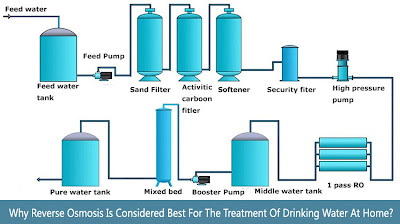Why reverse osmosis is considered best for the treatment of drinking water at home?
by Clear Ion Clear Ion Experts Pvt LtdThere are
innumerable techniques and water filters that can be used for the treatment of
drinking water at home and yes at different places in different conditions
different techniques and filters are taken into use for the purpose of treating
the drinking water in the right manner.
But
still, as one would get into the details and observe things correctly than
would realize that above all the other techniques and the types of purifiers reverse
osmosis is given the preference. So, for those who are new to the world of
water treatment or are new to the reverse osmosis technique here in this guide,
we will try to make the reasons associated with the preferred use of reverse
osmosis technology for the treatment of drinking water at home.
First and
foremost the things to be used at home should be safe, secure and also should
be easy for the understanding and for the use of the person. The reverse
osmosis water purification
filters do complete that criterion. But that is not
it there is much more that is associated with the reverse osmosis technique and
the filters and here we will discuss all of that in proper detail.
First of
all, let us discuss the components associated with the reverse osmosis that
make it advanced and thus preferable:
·
Water supply line valve: it
is from the supply valve that the user gets the raw water; it is an end to end
connection between the water supply and the system.
·
Pretreatment mechanism:
Sometimes the condition of the water is such that the raw water supply needs to
be pre-filtered in order to be made fit to be further treated by reverse
osmosis.
·
Semi-permeable membrane: one
can say that the semi-permeable membrane is the center of attraction of the
whole reverse osmosis system.
·
Post-treatment mechanism: in
the post-treatment process the reverse osmosis works on the elimination of
taste and odors from the water for that the water goes through another filter
or a whole set of new filters that has the carbon, sediments, and many other
things added.
·
Check valve assembly: This
component of the reverse osmosis system stops the purified water from running
back towards the membrane.
·
Flow restrictor: This
flow restrictor works on the interference of the uneven flow and thus protects
the quality of the water.
·
Storage Tank: The best thing
about an RO system is that it comes in various storage tank sizes the user can
decide and buy an RO system as per the needed storage capacity.
·
Auto- shut off valve: As soon
as the storage tank will be filled the further purification of water will be
stopped then and there.
·
Faucet/Tap: This
medium would finally deliver the treated water to be taken into use by the
people mostly for drinking purposes.
·
Drain Pipe: This is the pipe
through which all the impure water is given a run towards an outlet or a drain.
So,
reading all the information that has been given above one would realize that
undoubtedly an RO system is the most secure and safe way of getting well
treated and purified water for drinking and other domestic purposes other than
the ease of using the other features and advantages of using an RO system at
home would also be very clear in the head of the people. Before going to buy or
while planning the purchase of water treatment solutions there are certain
basics that should be clearly known to the people the knowledge surely would
help them and would direct them towards their right decision very smoothly.
So, this
is all regarding the preference of reverse osmosis over other water treatment
techniques and the purification providing ways and means. If a person still
feels confused and needs to gather more information or is stuck with the
installation of the system then in that case the user should get in touch with
the water treatment experts and the professionals. They will be able to
understand the exact need and therefore will be able to recommend the right
water treatment technique or the right filter. Though Reverse Osmosis in
India is preferred or water treatment at domestic levels
but still based on many factors the requirements at different places in
different situations may differ.
Sponsor Ads
Created on Nov 3rd 2020 05:41. Viewed 299 times.




